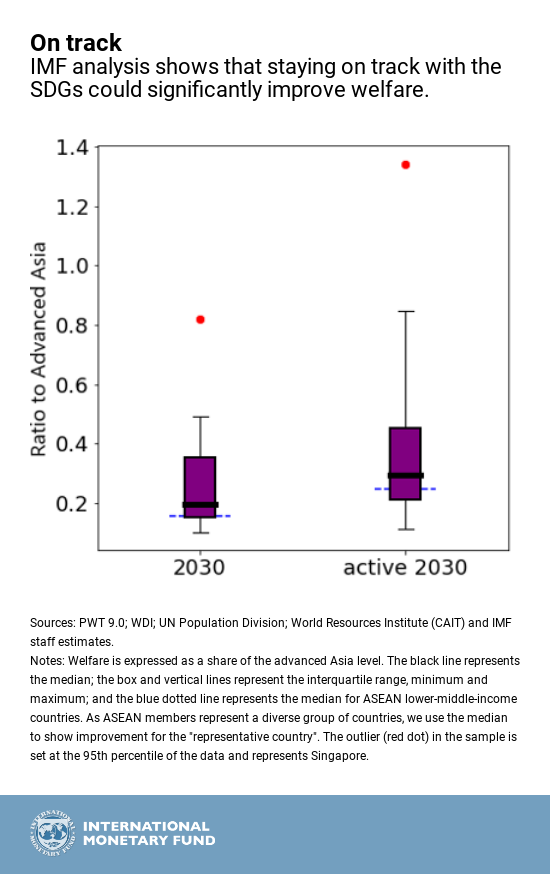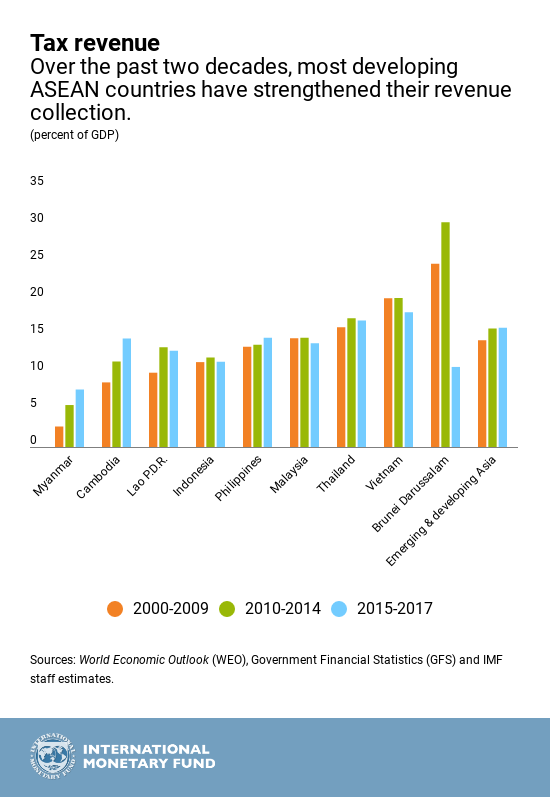
A farmer harvests rice fields in Hà Giang, Vietnam: ASEAN countries, of which Vietnam is a member, are on their way to achieving more sustainable development (photo: luctra_design/iStock)
ASEAN and the IMF: Staying on Track with the Sustainable Development Goals
November 8, 2018
The member countries of the Association of Southeast Asian Nations (ASEAN) continue to achieve strong growth, projected to average 5.2 percent for 2018. Such growth rates have helped to lower poverty, boost incomes, and improve economic welfare.
Related Links
A new report titled ASEAN Progress Towards Sustainable Development Goals and the Role of the IMF takes stock of the challenges ahead and provides an overview of how the IMF is supporting ASEAN countries as they pursue their development agendas.
The report recommends that countries adopt country-specific strategies, including more quality government spending on priority areas such as infrastructure, education and health, to help improve welfare and ensure that the benefits of growth are widespread.
Progress made
The 10 ASEAN member countries (Brunei, Cambodia, Indonesia, Laos, Malaysia, Myanmar, Philippines, Singapore, Thailand, and Vietnam) are well on their way to achieving more sustainable development. Strong income and consumption growth in recent years has reduced poverty, improved health and education outcomes, and led to greater inclusion, albeit to varying degrees across the ASEAN countries.
For example, with continued income growth and strong policies, most ASEAN countries are on track to eradicate absolute poverty by 2030, a major milestone for Southeast Asia. Maintaining this performance would also lead to significant improvements in health and education outcomes.
While basic health indicators show gaps, especially for the lower-middle income ASEAN countries, there are encouraging bright spots. For example, for the median ASEAN country, mortality for children under the age of five currently stands at 24.5 per 1,000 live births, already below the global goal.
If income gains based on recent forecasts are realized, and if past trends for sustainable development indicators continue, the IMF’s research finds that economic welfare (measured by prosperity levels and quality of living standards) will continue to converge towards the levels found in Asia’s developed economies.
Challenges ahead
While there has been some progress, the region still faces challenges to achieving the Sustainable Development Goals and improving economic welfare. For example, income inequality remains elevated in several ASEAN countries and the shift towards manufacturing is straining environmental sustainability.
Income inequality, as measured by the Gini coefficient—a commonly used measure of the income distribution—is almost 20 percent higher in the median ASEAN country than in advanced Asia.
Furthermore, life expectancy in the median ASEAN country (at about 69 years) remains well below advanced Asia, a gap that is projected to persist through 2030, suggesting that there is significant room to improve health outcomes. This is especially true in many lower middle-income ASEAN countries, which also need to invest more to close infrastructure gaps.
Working together
The IMF continues to work closely with ASEAN partners to support the region’s efforts to meet the Sustainable Development Goals, particularly in the areas of financial stability and sustainable and inclusive economic growth.
Over the past two decades, most developing ASEAN-member countries have strengthened revenue collection, reaching or going beyond the level of other developing countries in the region.
This matters for sustainable development as greater revenue from improved tax collection can help finance higher government spending on healthcare, education, social programs, and the environment in a fiscally sustainable manner. Cambodia and Myanmar, two of the main ASEAN recipients of the IMF’s technical assistance support, for example, have seen a significant increase in tax revenue as a share of GDP.
However, in most ASEAN countries, tax revenue-to-GDP ratios are still below 15 percent, highlighting the great challenges ahead. To further build support and capacity, the IMF has strengthened its engagement in developing countries through various initiatives—such as developing Medium-term Revenue Strategies (MTRS)—to help them boost their resource potential.
ASEAN countries have also received support through IMF initiatives in building capacity for infrastructure provision, pursuing inclusion, addressing the challenges of climate change, and strengthening economic institutions for good governance.
The way forward
Achieving more balanced, inclusive, and environmentally sustainable development in Southeast Asia—where countries are geographically, culturally, and economically diverse—calls for comprehensive, country-specific policy strategies.
Policies to improve environmental sustainability could include, for example, reducing distortions in fuel pricing and reducing energy subsidies, as well as potential tax policy measures such as carbon taxation. Examples of policies that can help tackle high income inequality include increasing reliance on progressive direct taxes and strengthening targeted social spending to improve safety nets.
While development needs will vary across countries, cost estimates suggest large spending needs for most ASEAN countries. For the lower-middle-income ASEAN countries, in particular, more determined policy efforts are needed to further improve health and education outcomes and infrastructure. Higher spending in these priority areas will require continued improvements in revenue mobilization and efforts to boost spending efficiency.
The IMF’s report shows how realistic policies to improve consumption, life expectancy, greenhouse gas emissions, and income inequality have the potential to significantly improve economic welfare in the ASEAN, bringing welfare for the ASEAN median country close to 30 percent of the estimated levels in advanced Asia by 2030.
The IMF stands committed to supporting ASEAN partners on the journey towards a more prosperous and sustainable future.









